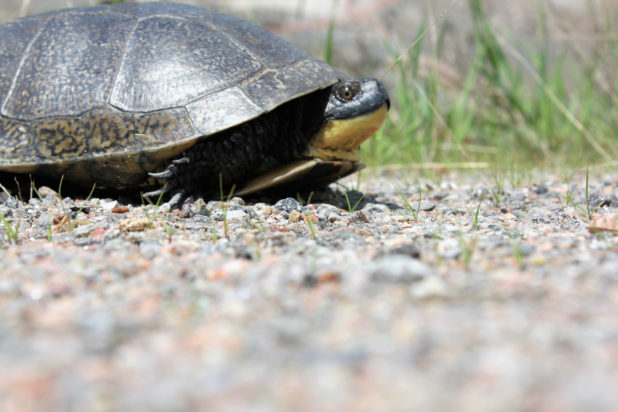General News
Campaign to protect Ontario’s Turtles continues
June 8, 2017

Blanding’s turtle laying eggs alongside Highway 118 in Cardiff. / NATE SMELLE Special to This Week
By Nate Smelle
For the past 57 years, Brian Ensoll (also known as Bri Bri the Turtle Guy) has been rescuing turtles from roadsides throughout Ontario. Since moving to the Bancroft area from his hometown of Scarborough in 1987, the Anderson Lake resident has continued his campaign to protect turtles in Ontario.
Ensoll’s love of turtles began early on in life when his grandfather taught him how to handle turtles in a safe way and encouraged him to help them whenever possible. Now, Ensoll along with his son Ryan and his cousin Nancy patrol the highways and roads every day in search of turtles that have been injured and others in need of assistance avoiding the ever-increasing traffic roaring through cottage country. The territory he looks after – which includes Bancroft – stretches from Gooderham to North Bay and from Pembroke to Renfrew.
When Ensoll is not helping turtles to escape the manmade dangers they face on the roads, he is in the classroom teaching the next generation how they can become active stewards of the environment by protecting turtles.
“Basically, what we are trying to do is raise awareness, because turtles are rapidly going extinct,” said Ensoll.
“The younger generation are too much into their handheld devices and not wildlife at all. One day soon, people are going to have their children and grandchildren come up to them and ask them what was this thing they use to call a turtle.”
Despite the fact Ontario has a greatest diversity of turtle species in Canada, seven of the eight turtles native in the province are at risk of going extinct. Biologists believe that the only reason the painted turtle currently remains off the list is because there is a lack of study of this species. Ontario’s spotted turtle, wood turtle, and Blanding’s turtle are under the greatest threat. Ensoll said there are many factors contributing to the decline of turtles in Ontario. These include habitat loss and habitat fragmentation, road and boat mortality, being hunted for food and then being poached to supply the pet trade.
Ensoll said if more is not done to protect turtles in Ontario, and throughout all of Canada for that matter, this ancient creature – which has been evolving on this planet for some 200 million years – could disappear within as little as eight years. Ensoll explained that if turtles were to suddenly vanish, the ecological niche they would leave vacant would likely destroy the balance of that entire biotic community. Considering an adult snapping turtle must lay approximately 1,500 eggs to reproduce a single adult turtle, the loss of a single adult would remove the other eggs and hatchlings that act as a food source for wildlife such as birds, fox, and wolves.
“It’s not just about the turtle, it’s about the food chain and the entire ecosystem,” he said.
“Very much like the bees and what they are going through right now. When they disappear a whole lot of things are going to change, right up to the human level. We have to pay more attention to Mother Nature because we are abusing it terribly.”
Despite the dire future that appears to lie in wait for turtles as development encroaches on their habitat from all directions, Ensoll said he has seen signs of hope that people are starting to understand why turtles need to be protected. For instance, this spring the government in Ontario permanently banned the hunting of snapping turtles, to allow the species a chance to make a comeback. Encouraging caution among the public when trying to assist a snapping turtle, Ensoll said it is essential that people learn how to properly move these creatures out of harm’s way. If someone doesn’t know how to move them safely, he suggested using a flat square shovel to coax them in the direction they are facing.
“When picking up a turtle or moving them from the road, you always need to make sure you move them in the direction they’re facing,” he said.
“If you turn them around, they are just going to head back in the direction where they are going. The most important thing I tell people is to put your own safety first. A lot of the people driving up north from the city are always in a big rush, so you need to be very careful.”
When Ensoll comes across an injured turtle, he usually transports it to the Kawartha Turtle Trauma Centre in Peterborough. There are other facilities located in cottage country however, so he advises taking the animal to the nearest one. Finding an injured turtle that has been struck by a car or a boat is always a heartbreaking moment.
“Whenever I find one that has been hit I can’t help but cry. Sometimes they are hurt so bad there is nothing you can do, but I always try and take them in if they are still alive. It’s amazing how they can recover from even really bad injuries if you get them to a trauma centre before it’s too late.”
To learn more about how to protect turtles visit the Ontario Turtle Conservation Centre (home of Kawartha Turtle Trauma Centre) online at www.ontarioturtle.ca; or contact bribritheturtleguy@gmail.com.

















